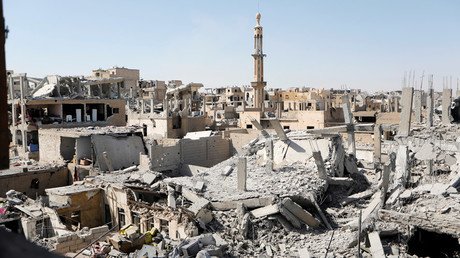A large number of bodies, many of them women and children, are still buried under the rubble in Mosul after the months-long operation to retake the city. RT’s Murad Gazdiev saw the gruesome aftermath of the battle declared a major success by the US-led coalition.
Multiple corpses of suspected Islamic State (IS, formerly ISIS/ISIL) militants – but also civilians – are still lying under the rubble in the sweltering August heat.
Rescuers are working to retrieve corpses buried under collapsed houses, with many buildings literally reduced to ashes – possibly in the aftermath of bombings or artillery strikes. Parts of Mosul that were once residential areas are now ruins.
While the scenes of devastated streets still leave a grim impression, there is another harrowing feature that cannot be seen on television – the sickly odor of decomposing bodies, Gazdiev said.
“You’ve probably heard of thousands killed, the civilian suffering,” he says, standing among the Mosul ruins. “What you likely haven’t heard of is the smell. It’s nauseating, repulsive, and it’s everywhere – the smell of rotting bodies.”
As the RT team walks through the Old City, the camera captures the picture of destruction in what was once Iraq’s second-largest city. Burnt-out vehicles littered along the roadside, damaged walls and empty windows depict the heavy price that civilians paid for the Iraqi and US-led coalition’s Mosul victory.
“Under the rubble there are hundreds and hundreds of corpses – jihadists as well as civilians and families,” Gazdiev reported. Two women and two children have been pulled out just this morning, he said, adding that there’s no end in sight for those whose work is to recover the bodies.
Local emergency services working in the Old City say they were equally shocked and scared when they realized the number of casualties. “What I’ve seen here makes me cry,” one Iraqi officer, Ibrahim, told RT.
“You can bring anyone here and they will break down in tears because we’re all human beings,” he said.
Rescuers will probably need months to unearth all the bodies, and months more to start reconstruction of the city. More than $1 billion will be needed to repair Mosul’s basic infrastructure alone, according to UN estimates.
In the meantime, “stabilization” costs that included an overhaul of water, sewage and electricity infrastructure, and reopening schools and hospitals, twice exceeded initial calculations, Lise Grande, the United Nations humanitarian coordinator for Iraq, told Reuters back in July.
“In western Mosul what we're seeing is the worst damage of the entire conflict. In those neighborhoods where the fighting has been the fiercest, we're looking at levels of damage incomparable to anything else that has happened in Iraq so far,” she said.


